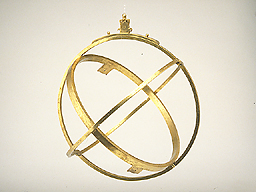
 |
| Catalogue |
 |
 Astronomical Ring Dial The instrument is suspended from a swivelling ring attached to the throne that in turn is screwed to the fixed meridian ring. The throne is left blank. The fixed meridian ring is twice marked on the rim 'MERIDIANVS'. The top is further marked 'Polus arcticus' and the bottom 'Polus antarcticus'. The latitude scale (90? to 0? to 90?) on the meridian ring serves for setting the instrument for the appropriate latitude. The bottom of the meridian ring is signed 'G.A. nepos Gemme Fris? Louan? fecit anno 1572' ['Made by Gualterus Arsenius, nephew of Gemma Frisius from Louvain, in 1572']. The equatorial ring, which is perpendicular to the fixed meridian ring, bears a combined zodiacal/calendrical scale for determining the zodiacal position of the Sun from the (Julian) calendar date. The ring is further marked '?QVINOCTIALIS', '?QUATOR', 'Umbra recta' and 'Umbra versa'. The mobile meridian ring is rotates around the celestial poles. The outer rim and the perpendicularly mounted equatorial ring both contain eight-pointed star symbols and the names of the following thirty stars: 'Cauda ceti', 'Venter ceti', 'Eridani extremi', 'Medium pleiades', 'Oculus [Taurus]', 'Hircus', 'Orionis sin.hum.pes', 'Dexter hum. Orionis', 'Canopus', 'Canis maior', 'Caput [Gemini] ante.', 'Canicula', 'Lucida h?dr?', 'Cor [Leo]', 'Cauda [Leo]', 'Principium cau.vr.ma.', 'Spica [Virgo]', 'Extrema cau.vrs.ma.', 'Arcturus', 'Lanx meridionalis', 'Corona Septen.', 'Cor [Scorpio]', 'Cauda [Scorpio]', 'Caput Ophiuchi', 'L?ra', 'Genu sinister [Sagittarius]', 'Aquila', 'Cauda c?gni', 'Postrema aque fuse' and 'Umbilicus pegasi'. Inside the mobile meridian ring there is a ring with a pair of sighting holes which can be adjusted for taking the bearing of one of the above mentioned stars. The instrument (previously catalogued as Obs A 2) has been on loan from the Leiden Observatory since 1931. Of its previous history, before it was found around 1868 in the attic of the Leiden University Library, nothing is known. See K. van Cleempoel et al, Instrumentos Cientificos del Siglo XVI: la Corte Espa?ola y la Escuela de Lovaina (Madrid, 1997), pp. 97 and 164-5, (p. 110 in the English summary). Robert van Gent |



